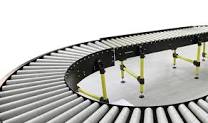
CONVEYOR BELTS
Conveyor belts are continuous-loop transport systems consisting of a belt made of various materials, supported by rollers or pulleys at each end. They are widely used in industrial settings to move goods or materials from one location to another, making material handling more efficient and automated.
Product Feature
1. Diverse Materials: Conveyor belts are available in a wide range of materials, including rubber, PVC, fabric, steel, and more, to suit specific applications and material types.
2. Customizable Length and Width: Conveyor belts can be customized in terms of length and width to match the requirements of different industries and processes.
3. Variety of Belt Types: Different types of belts, such as flat, modular, cleated, and timing belts, are available to accommodate specific material handling needs.
4. Conveyor Configurations: Conveyor systems can be designed in various configurations, including straight, curved, inclined, and spiral, to optimize space and facilitate material flow.
5. Automation Integration: Conveyor belts can be easily integrated with automation systems, allowing for precise control of material movement and monitoring.
6. High Load Capacity: Many conveyor belts are designed to handle heavy loads and withstand the rigors of industrial environments.
Safety Features: Conveyor systems can include safety features such as emergency stops, guards, and sensors to ensure safe operation.
Product Application
1. Efficiency: Conveyor belts automate material handling processes, reducing the need for manual labor and speeding up the movement of goods, ultimately improving overall efficiency.
2. Cost Savings: By streamlining material handling and reducing labor requirements, conveyor systems help lower operational costs and increase productivity.
3. Versatility: Conveyor belts are suitable for a wide range of industries, including manufacturing, logistics, mining, agriculture, and more, making them highly versatile.
4. Space Optimization: Conveyor systems can be configured to fit within available space, making them ideal for facilities with limited floor space.
5. Consistency: Automated conveyor systems ensure consistent and reliable material movement, reducing the risk of errors and disruptions in production.
6. Safety: Conveyor systems enhance workplace safety by reducing manual handling, minimizing the risk of worker injuries, and providing safety features for emergency situations.
7. Reduced Material Damage: Conveyor belts are designed to handle materials gently, reducing the risk of product damage during transportation.
8. Scalability: Conveyor systems can be easily expanded or modified to accommodate changing production needs, allowing for scalability in operations.
9. Environmental Benefits: Conveyor systems can contribute to environmental sustainability by optimizing material flow, reducing energy consumption, and minimizing waste.




